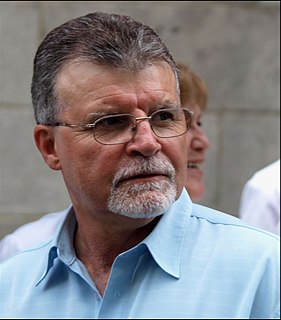Related Research Articles

Whitehorse is the capital and only city of Yukon, and the largest city in northern Canada. It was incorporated in 1950 and is located at kilometre 1426 on the Alaska Highway in southern Yukon. Whitehorse's downtown and Riverdale areas occupy both shores of the Yukon River, which originates in British Columbia and meets the Bering Sea in Alaska. The city was named after the White Horse Rapids for their resemblance to the mane of a white horse, near Miles Canyon, before the river was dammed.

Yukon is the smallest and westernmost of Canada's three territories. It has the smallest population of any province or territory in Canada, with a population of 35,874 people. Whitehorse, the territorial capital and Yukon's only city, is the largest settlement in any of the three territories.

Dennis G. Fentie was a Canadian politician. He was the seventh Premier of Yukon and leader of the Yukon Party, serving from 2002 to 2011, as well as the MLA for Watson Lake.

Dawson City, officially the Town of the City of Dawson, is a town in the Canadian territory of Yukon. It is inseparably linked to the Klondike Gold Rush (1896–99). Its population was 1,375 as of the 2016 census, making it the second largest town of Yukon.

The Klondike Highway is a highway in the borough of Skagway, Alaska, United States and in the province of British Columbia and the territory of Yukon in Canada, that links the Alaskan coastal town of Skagway to Yukon's Dawson City. Its route somewhat parallels the route used by prospectors in the 1898 Klondike Gold Rush.
Peter William Jenkins is a Canadian politician, who has served as deputy premier and health minister in the territorial government of the Yukon, and as mayor of Dawson City.

Hilda Pauline Watson was a Canadian schoolteacher and politician from the Yukon Territory. She was the first woman in Canadian history to lead a political party which was successful in having its members elected.

Kluane is an electoral district which returns a member to the Legislative Assembly of the Canadian territory of Yukon. It is named after Kluane National Park, which is within the riding. It is one of the Yukon's eight rural districts.
The Yukon Territorial Council was a political body in the Canadian territory of Yukon, prior to the creation of the Yukon Legislative Assembly. Although not a full legislature, the council acted as an advisory body to the Commissioner of Yukon, and had the power to pass non-binding motions of legislation which would be forwarded to the commissioner for consideration.
Fred Berger (1932–2009) was a Canadian politician. First elected to the non-partisan Yukon Territorial Council in the 1974 territorial election, he became the first leader of the Yukon New Democratic Party when the territory adopted political parties for the first time in the 1978 election. Berger was not elected to the Yukon Legislative Assembly, however, losing to Meg McCall in the Klondike electoral district.
Whitehorse electoral district was a territorial electoral district in the Yukon Territory Canada. The electoral district was created in 1903.
Dawson electoral district was a territorial electoral district in the Yukon Territory, Canada, which elected a member to the Yukon Territorial Council. The electoral district was created in 1920 by the merger of the former districts of North Dawson and South Dawson. The electoral district once reached the far north of Old Crow by the 1970 election, and was redistricted in 1974 election
Eleanor Millard is a Canadian writer and former politician. Born in North Vancouver, British Columbia, Millard graduated from the University of British Columbia in 1965. After graduation, Millard moved to the Yukon, where she worked as a barmaid at a hotel in Dawson City before finding a permanent job as a social worker.
Mayo was an electoral district which returned an MLA to the Legislative Assembly of the Yukon Territory in Canada. It was created in 1928, at a time when it was one of three districts who elected advisors to the Yukon Territorial Council. The more contemporary, final iteration of the riding was created from an amalgamation of the riding with part of the riding of Klondike. It was abolished in 1992 when it was amalgamated with the riding of Tatchun to form the riding of Mayo-Tatchun.
John Ormrod Livesey was a Canadian politician, who served on the Yukon Territorial Council from 1958 to 1964 and from 1967 to 1970. He represented the district of Carmacks-Kluane, and served as Speaker of the Council.
Whitehorse Riverdale was a territorial electoral district in the Canadian territory of Yukon, which was represented on the Yukon Territorial Council from 1974 to 1978. The district consisted primarily of the Riverdale area in the capital city of Whitehorse.
Whitehorse Porter Creek was a territorial electoral district in the Canadian territory of Yukon, which was represented on the Yukon Territorial Council from 1974 to 1978. The district consisted primarily of the Porter Creek area in the capital city of Whitehorse.
Pelly River was a territorial electoral district in the Canadian territory of Yukon, which was represented on the Yukon Territorial Council from 1974 to 1978. The district consisted primarily of town of Faro, as well as much of the rural northeast quadrant of Yukon.
The 23rd Yukon Territorial Council, the final term of the Yukon Territorial Council before it was replaced with the contemporary Legislative Assembly of Yukon, was in session from 1974 to 1978. Membership was set by the 1974 Yukon general election, with one followup by-election in 1975 after the election of Willard Phelps was overturned on conflict of interest grounds.
References
- 1 2 Max Fraser, "Dawson City May Have No Reps Instead of Two". Whitehorse Star , November 13, 1974.
- ↑ "Yukon vote: Voters elect largest council ever". Ottawa Citizen , November 19, 1974.
- ↑ "Dawson reunited". Whitehorse Star , November 7, 1978.